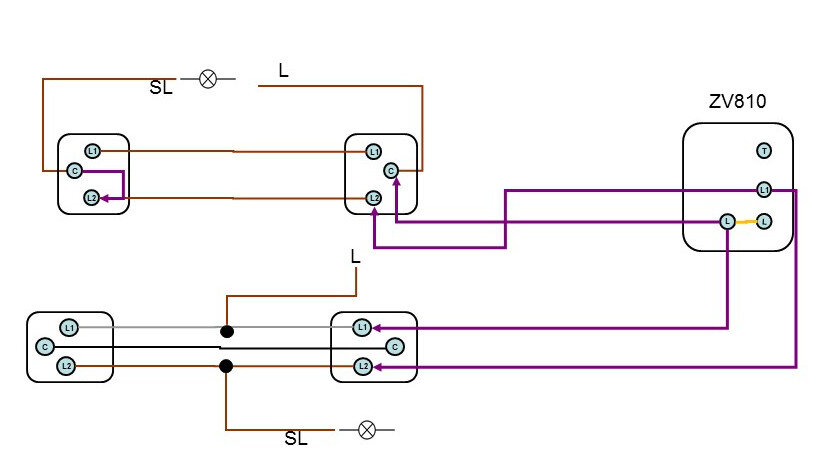Basically been asked to look into a solution for a customers dwelling / dwellings where they have flats in the same building as they live. At present has old mostly 2 gang switching along ground hallway and up various stairways and between landings and these are junction box wired from two seperate cu's one at entry hall and very last lights from near top floor small cu, the cabling is full of the old di-isoctyl phthalate (Green goo) and as tenants are leaving the switches on all night etc.. and costing them a fortune in electricity bills, they would like some kind of time lag or similar switching arrangement implemented.
Sounds easy enough only the latest kit he supplied for me to try and fit were Time guard ZV810's with PIR built in to them. 2 Gang switch near front door operating porch outside light 1 way and second gang is 2 way to bottom of stairs 2 gang. Only red, yellow, blue 3 core at switches as per JB system. Wired 3 core from existing switch into the ZV and it worked fine with one fitted each end, go to next gang at bottom of stairs linked presumably to 1 of 2 gangs on next stair landing and if a ZV / lag switch fitted there it would not work at all ! So started belling out cores to check cables were going to right places lol, and while checking afterwards I found I have all kinds of weird voltages floating around the 2 way switch terminals while switches are in different positions !
So so far a few different types of time lag switches haven't worked on the shoddy arrangement and I'm not sure any will without rewiring the hall and stairwells all the way up which would be very awkward.
As far as having say stray voltages on jb wired 2 way lighting I have seen that a few times on old houses etc.. is this likely a borrowed neutral issue or other ropey connection problem likely ?
Voltages I have got were not with a true rms tester but a Fluke T5 so might be part of the problem ?
I had for instance 60V between strappers and com to strapper in one position and then 40V strapper to cpc and when switch position operated I'd get 240V between one core and cpc but 2 other cores to cpc reading 24V for both ! Weird as..
Sounds easy enough only the latest kit he supplied for me to try and fit were Time guard ZV810's with PIR built in to them. 2 Gang switch near front door operating porch outside light 1 way and second gang is 2 way to bottom of stairs 2 gang. Only red, yellow, blue 3 core at switches as per JB system. Wired 3 core from existing switch into the ZV and it worked fine with one fitted each end, go to next gang at bottom of stairs linked presumably to 1 of 2 gangs on next stair landing and if a ZV / lag switch fitted there it would not work at all ! So started belling out cores to check cables were going to right places lol, and while checking afterwards I found I have all kinds of weird voltages floating around the 2 way switch terminals while switches are in different positions !
So so far a few different types of time lag switches haven't worked on the shoddy arrangement and I'm not sure any will without rewiring the hall and stairwells all the way up which would be very awkward.
As far as having say stray voltages on jb wired 2 way lighting I have seen that a few times on old houses etc.. is this likely a borrowed neutral issue or other ropey connection problem likely ?
Voltages I have got were not with a true rms tester but a Fluke T5 so might be part of the problem ?
I had for instance 60V between strappers and com to strapper in one position and then 40V strapper to cpc and when switch position operated I'd get 240V between one core and cpc but 2 other cores to cpc reading 24V for both ! Weird as..









